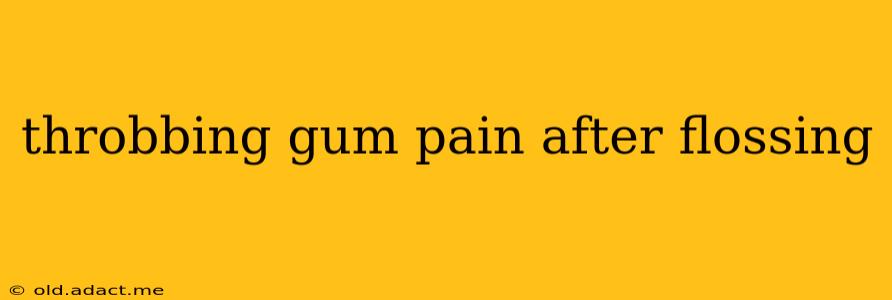Flossing is crucial for maintaining good oral hygiene, yet sometimes, this beneficial practice can lead to unpleasant throbbing gum pain. This isn't necessarily a sign of something seriously wrong, but it's important to understand the potential causes and how to address them. This article will explore the reasons behind post-flossing gum pain, offer effective remedies, and provide preventative measures to ensure your flossing routine remains pain-free.
Why Does My Gum Throb After Flossing?
The most common cause of throbbing gum pain after flossing is gingivitis, an early stage of gum disease. Gingivitis is characterized by inflamed gums, often appearing red, swollen, and tender to the touch. Flossing, while beneficial, can irritate already inflamed gums, leading to throbbing pain. The pressure of the floss on sensitive gum tissue can exacerbate the inflammation.
Is it Gum Disease?
Yes, throbbing gum pain after flossing can be a symptom of gum disease. However, it's important to note that not all gum pain indicates severe disease. Early-stage gingivitis is often treatable with improved oral hygiene. However, if left untreated, gingivitis can progress to periodontitis, a more advanced form of gum disease that can lead to tooth loss.
What if My Gums Bleed When I Floss?
Bleeding gums are another common sign of gingivitis. The inflammation weakens the blood vessels in the gums, making them prone to bleeding. While some bleeding is normal during the initial stages of improved oral hygiene, persistent bleeding warrants a visit to the dentist.
How Can I Treat Throbbing Gum Pain After Flossing?
Several remedies can help alleviate throbbing gum pain:
- Saltwater Rinse: Dissolve half a teaspoon of salt in a glass of warm water and gently rinse your mouth several times a day. Saltwater possesses natural antiseptic properties that can soothe inflamed gums.
- Over-the-Counter Pain Relief: Pain relievers like ibuprofen or acetaminophen can help reduce pain and inflammation. Always follow the dosage instructions on the packaging.
- Gentle Brushing and Flossing: Avoid aggressive brushing and flossing. Use a soft-bristled toothbrush and gentle, sweeping motions. Be careful not to force the floss between your teeth.
- Avoid Irritants: Temporarily avoid acidic foods, hot beverages, and other irritants that might further aggravate your gums.
How Can I Prevent Throbbing Gum Pain When Flossing?
Prevention is key to avoiding post-flossing discomfort:
- Proper Flossing Technique: Learn and practice proper flossing technique. Use a gentle sawing motion to guide the floss between your teeth, curving it around each tooth in a "C" shape.
- Regular Dental Checkups: Regular visits to your dentist are essential for early detection and treatment of gum disease.
- Consistent Oral Hygiene: Brush your teeth twice a day with fluoride toothpaste and floss daily.
- Choose the Right Floss: Experiment with different types of floss to find one that's comfortable and effective for you. Waxed floss may be gentler on sensitive gums.
What Should I Do if the Pain Persists?
If the throbbing gum pain persists despite home remedies, schedule an appointment with your dentist. They can accurately diagnose the cause of your pain and recommend appropriate treatment. Ignoring the problem could lead to more severe dental issues. Early intervention is crucial for maintaining optimal oral health.
This information is for general knowledge and does not constitute medical advice. Always consult with a dental professional for diagnosis and treatment of any oral health concerns.
